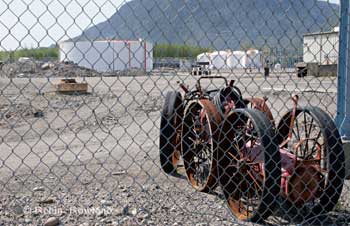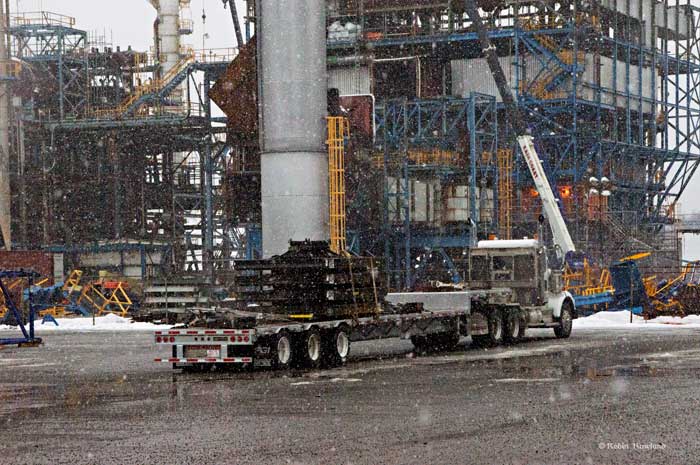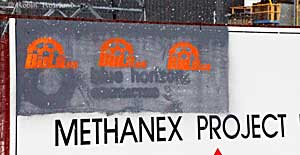![]() Shell Canada has confirmed that, with three partners, it is developing a giant proposed liquified natural gas export facility at Kitimat.
Shell Canada has confirmed that, with three partners, it is developing a giant proposed liquified natural gas export facility at Kitimat.
The project could see up to 12 million tonnes of LNG exported from Kitimat each year. What the companies are now calling LNG Canada would be built in two “trains” or stages, with each producing six million tonnes. A news release from Shell says there is an option to expand the project beyond the 12 million tonne capacity.
The announcement made international news. The Chicago Tribune said Tuesday. “Kitimat… looks set to become a major supply hub for the Pacific Rim.”
Shell’s partners, Korea Gas Corporation, Mitsubishi Corporation, and PetroChina Company Limited will work to export natural gas, mostly from northeastern British Columbia, combining the “four companies’ extensive development experience, technical depth, financial strength and access to markets required to be the leading LNG developer in Canada.”
The four companies did not say how much money is involved in the project. Reports in the Japanese media said the project could cost as much as $12 billion US.
Shell holds a 40 per cent working interest. The partners KOGAS, Mitsubishi and PetroChina each hold a 20 per cent working interest.
“Our combined expertise, and our focus on technological innovation in delivering safe and environmentally sound LNG projects around the globe, ensures that our LNG Canada project would be well-suited to deliver long-term value for British Columbia and increase access to new export markets for Canada,” says Jose-Alberto Lima, Vice President LNG Americas, Shell Energy Resources Company in a news release.
News releases from both Shell and Petrochina both say:
The proposed LNG Canada project includes the design, construction and operation of a gas liquefaction plant and facilities for the storage and export of liquefied natural gas (LNG), including marine off-loading facilities and shipping. LNG Canada can create significant economic benefit for the province, First Nations, local communities and the region. Such a project can create thousands of jobs during construction and hundreds of full-time, permanent jobs during operations. Such a significant energy project can also bring indirect economic development opportunities to the region.
Shell and PetroChina say:
A decision to move this project into development would be taken after conducting necessary engineering, environmental and stakeholder engagement work with start up around the end of the decade, pending regulatory approvals and investment decisions.
The approval process will begin with a formal consultation process with First Nations and local community residents.
“This project will contribute to a further strengthening of trade relationships between China and Canada and will help China use clean burning natural gas to fuel its economic growth,” Bo Qiliang, Vice President, PetroChina, said in the release.
“We are sitting on the doorstep of a very fast-growing market that actually wants to come to Canada because they see it as long-term stability and a secure source of supply,” Shell Canada president Lorraine Mitchelmore said. “We are now, for the first time in the natural gas industry, very competitive with other countries like Australia.”
Kitimat Mayor Joanne Monaghan said her and the District Council have been working on the project for sometime. “Council have been aware of it and have rolled up their sleeves for almost a year and half to two years,” the mayor said.

One aspect was making sure Kitimat is ready for the project, Monaghan said: “We had to make sure there were hospital facilities, rental facilities, that we had housing available. We were getting all our inventories together. Now we know and now we can go full blast ahead.”
Monaghan hopes that eventually Kitimat will return its population peak of between 10,000 and 15,000 residents. (Since the closure of the Eurocan craft paper mill in 2010, Kitimat’s population dropped to around 8,000 but that number has been growing with the LNG projects and the Rio Tinto Alcan Kitimat Modernization Project, even though the KMP project will eventually mean fewer jobs at the aluminum smelter).
“If they have the five to seven thousand construction workers they’re looking for, they will bring in workers from all over BC, probably all over Canada,” Monaghan said.
Shell purchased the former Methanex plant site and the related Kitimat port terminal last fall, raising worldwide speculation about the LNG project. The Methanex site is now used by Cenovus to transport bitumen condensate by rail from Kitimat to the Alberta oil sands. Much of the old Methanex plant has been decommissioned and is being shipped to a buyer in China.
Most of the natural gas supply will come from the booming Horn River and Montney shale gas formations in northeastern British Columbia.
Reports say that LNG Canada will work with a third party that would build and probably own a pipeline from the northeast to the coat.
The profit picture comes from the fact that LNG prices in Asia, based on a proportion of the world price of oil, are much higher than the price of natural gas in North America, where the shale gas boom has driven gas prices to a record low.
The price boom in Asia could be a windfall for British Columbia, which could receive up to $600 billion in natural gas royalties over the next 25 years.
There is also fierce international competition to send LNG to Asia. The major energy companies are investing heavily in projects in Australia, while traditional suppliers like Qatar and Russia are ramping up their marketing efforts to Asia.

As of this week, Japan began closing down the last of its nuclear electrical generation capacity. After the March 11, 2011 earthquake, that country became a major customer for current and future liquified natural gas projects.
Since the earthquake last year, two other projects in Kitimat have proceeded. The Kitimat LNG project, a partnership called KM LNG led by Apache Corporation, Encana Corp, and EOG Resources plan to start up a Kitimat LNG plant in 2015, at Bish Cove with an initial capacity of five million tonnes a year. That project has been approved by the National Energy Board but is still waiting for a final go ahead from the boards of the three corporations, expected now in the fourth quarter of 2012.
A second project, called BC LNG, owned by the Haisla Nation in partnership with Houston-based LNG Partners, will act as broker and exporter for other LNG companies, facilitating exports to Asia from a barge based facility at North Cove, with the first shipment expected in 2014 or 2015.
There are also reports that Malaysia’s Petronas in partnership with Calgary-based Progress Energy Resources Corp., which have major stakes in B.C. shale are also looking for a possible LNG terminal on the west coast. As well, Talisman Energy, Nexen and Imperial Oil are also looking at west coast projects.
Related Links
News release from BC Premier Christy Clark Premier Applauds Progress on Kitimat Project: LNG Canada

